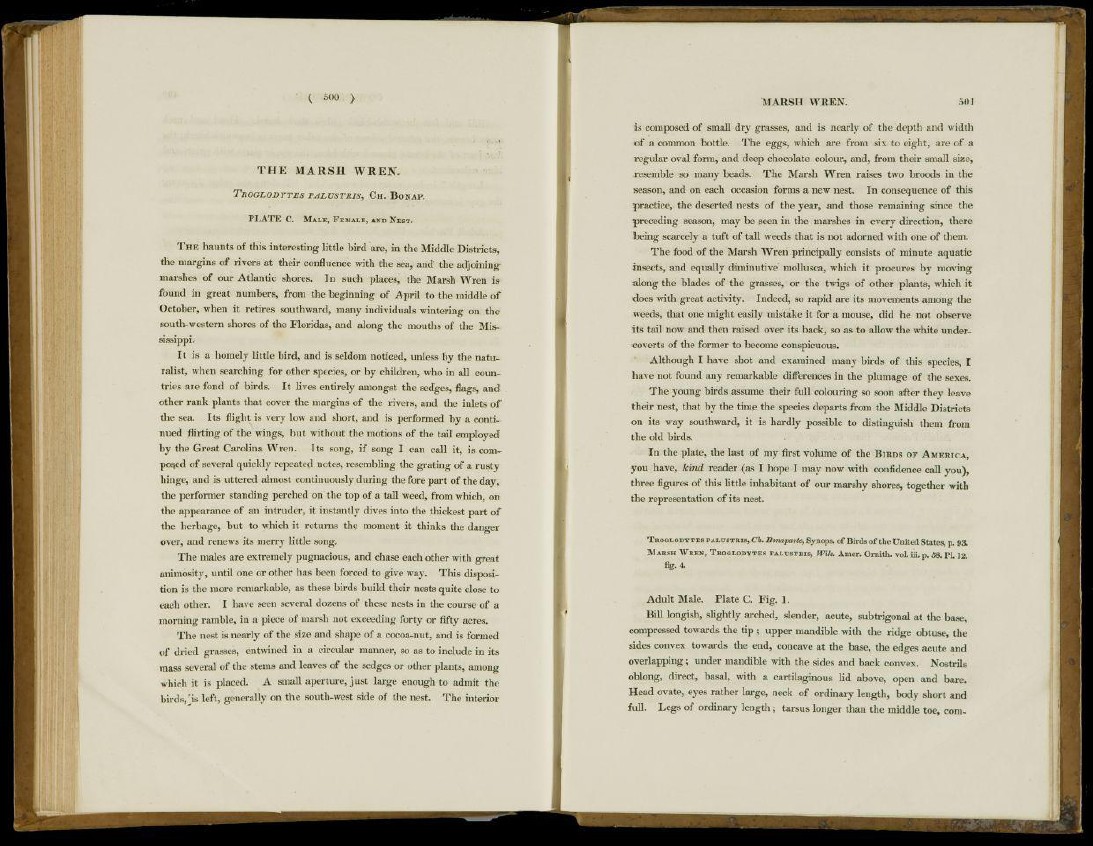
( 500 >
T H E MARSH WREN.
TROGLODYTES PALUSTRIS, CH. BONAP.
PLATE C. MALE, FEMALE, AND NEST.
THE haunts of this interesting little bird are, in the Middle Districts,
the margins of rivers at their confluence with the sea, and the adjoining
marshes of our Atlantic shores. In such places, the Marsh Wren is
found in great numbers, from the beginning of April to the middle of
October, when it retires southward, many individuals wintering on the
south-western shores of the Floridas, and along the mouths of the Mississippi.
It is a homely little bird, and is seldom noticed, unless by the naturalist,
when searching for other species, or by children, who in all countries
are fond of birds. It lives entirely amongst the sedges, flags, and
other rank plants that cover the margins of the rivers, and the inlets of
the sea. Its flight is very low and short, and is performed by a continued
flirting of the wings, but without the motions of the tail employed
by the Great Carolina Wren. Its song, if song I can call it, is composed
of several quickly repeated notes, resembling the grating of a rusty
hinge, and is uttered almost continuously during the fore part of the day,
the performer standing perched on the top of a tall weed, from which, on
the appearance of an intruder, it instantly dives into the thickest part of
the herbage, but to which it returns the moment it thinks the danger
over, and renews its merry little song.
The males are extremely pugnacious, and chase each other with great
animosity, until one or other has been forced to give way. This disposition
is the more remarkable, as these birds build their nests quite close to
each other. I have seen several dozens of these nests in the course of a
morning ramble, in a piece of marsh not exceeding forty or fifty acres.
The nest is nearly of the size and shape of a cocoa-nut, and is formed
of dried grasses, entwined in a circular manner, so as to include in its
mass several of the stems and leaves of the sedges or other plants, among
which it is placed. A small aperture, just large enough to admit the
birds,'is left, generally on the south-west side of the nest. The interior
MARSH WREN.
is composed of small dry grasses, and is nearly of the depth and width
of a common bottle. The eggs, which are from six to eight, are of a
regular oval form, and deep chocolate colour, and, from their small size,
resemble so many beads. The Marsh Wren raises two broods in the
season, and on each occasion forms a new nest In consequence of this
practice, the deserted nests of the year, and those remaining since the
preceding season, may be seen in the marshes in every direction, there
being scarcely a tuft of tall weeds that is not adorned with one of them.
The food of the Marsh Wren principally consists of minute aquatic
insects, and equally diminutive mollusca, which it procures by moving
along the blades of the grasses, or the twigs of other plants, which it
does with great activity. Indeed, so rapid are its movements among the
weeds, that one might easily mistake it for a mouse, did he not observe
its tail now and then raised over its back, so as to allow the white under-
«overts of the former to become conspicuous.
Although I have shot and examined many birds of this species, I
have not found any remarkable differences in the plumage of the sexes.
The young birds assume their full colouring so soon after they leave
their nest, that by the time the species departs from the Middle Districts
on its way southward, it is hardly possible to distinguish them from
the old birds.
In the plate, the last of my first volume of the BIRDS OF AMERICA,
you have, hind reader (as I hope I may now with confidence call you),
three figures of this little inhabitant of our marshy shores, together with
the representation of its nest.
TROGLODYTES PALUSTRIS^CA. Bonaparte, Synops. of Birds of the United States, p. 9 3 .
MARSH WREN, TROGLODYTES PALUSTRIS, Wilt. Amer. Ornith. vol. iii. p. 58. PL 12.
fig. 4.
Adult Male. Plate C. Fig. 1.
Bill longish, slightly arched, slender, acute, subtrigonal at the base,
compressed towards the t i p ; upper mandible with the ridge obtuse, the
sides convex towards the end, concave at the base, the edges acute and
overlapping ; under mandible with the sides and back convex. Nostrils
oblong, direct, basal, with a cartilaginous lid above, open and bare.
Head ovate, eyes rather large, neck of ordinary length, body short and
full. Legs of ordinary length ; tarsus longer than the middle toe, com